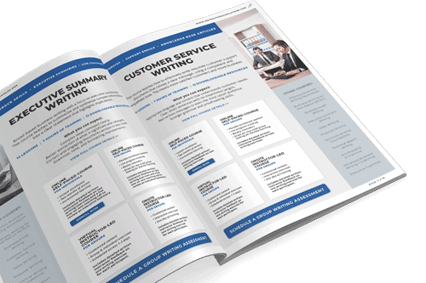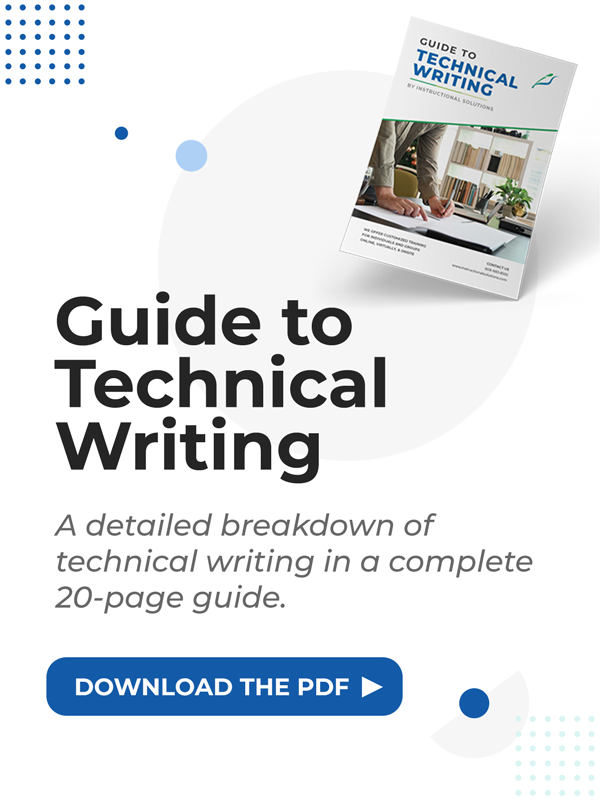Tips on using ChatGPT for Business Writing [With Examples]

Originally published April 24, 2023, updated April 25, 2023
![Tips on using ChatGPT for Business Writing [With Examples]](https://www.instructionalsolutions.com/hubfs/using-ai-prompts-in-business-writing-question-mark-screen.jpg)
Table of Contents
AI output is only as good as the questions (and follow-up questions) that are inputted. Crafting clear and specific prompts is the most important tip using these powerful tools.
All of our online courses include even more tips and tricks on how to best use ChatGPT and AI at work for email writing, proposal writing, report writing, blog posts, social media posts, and more. It can be a valuable tool but only when you know how to use it correctly.
Weak prompts equal poor writing
If the prompt is generic, any AI's response will be just as basic. ChatGPT is a powerful language model, but it requires detailed prompts to give relevant, and human-like responses.
Have you seen ChatGPT in action yet? It’s amazing to see the text created, but the email ChatGPT wrote in the example below is weak. Far too many words are used to share only a few points.
We asked ChatGPT to "write an email to my employee to ask them to update our SOP with the new processes we developed in the meeting last week."
Here is what it gave in its initial response:
Subject: Request to Update Standard Operating Procedures (SOP) with New Processes
Dear [Employee Name],
I hope this email finds you well. I am reaching out to you to request an update to our Standard Operating Procedures (SOP) with the new processes that were developed in the meeting we had last week.
As you are aware, the meeting was held to discuss the improvements and changes needed to streamline our processes and procedures. It was decided that we need to update our SOP to reflect the changes we discussed and agreed upon in the meeting. These changes are critical to ensuring that we maintain the highest standards of quality, efficiency, and effectiveness in our operations.
I am writing to request that you take charge of updating our SOP with the new processes discussed in the meeting. I believe that your attention to detail and expertise in this area make you the ideal candidate for this task. I would appreciate it if you could complete this task within the next two weeks so that we can implement the changes as soon as possible.
Please feel free to reach out to me if you have any questions or require any assistance with this task. Thank you in advance for your efforts and for your dedication to ensuring that our organization operates at its best.
Best regards,
[Your Name]
Boring, right? There is some good content, but far too many words are used to express too little information. And there are a lot of assumed details that may not be true or relevant. Better prompts could resolve this, but not entirely. This text would require heavy editing.
This is just one example, but there are, of course, a range of business applications and documents you could ask any artificial intelligence tool to write for you. Without a strong prompt though, you will get something along the same lines as the poorly written example above.
Let's look at how to write a clear, more specific prompt to get a more accurate response.
How to write effective prompts to use ChatGPT at work
The process for writing a prompt is the same as the start of writing any business document. This is why artificial intelligence tools aren't the perfect tool for business writing. If you don't have the proper skills to write the document yourself, you won't know how to write an effective prompt.
Here are a few tips for getting relevant responses from AI tools:
- Before you enter a prompt, first ask yourself, “Who is my reader? What do I want them to know or do after reading this?"
The answers to these questions are your roadmap. If ChatGPT isn’t addressing this, you must refine the prompts further until the text generated is relevant to this. - Refining your prompts can be as vexing as outlining a document from scratch. It requires discernment and critical thinking. Simple prompts alone are not enough.
This is why academic use of artificial intelligence tools has been so popular (and successful!). Often, a professor gives a student detailed instructions on what exactly they should be writing, how many words or paragraphs they should include, etc. These details help guide ChatGPT to the exact result the user is looking for. - Try using ChatGPT to draft a document for you based on an outline that you've already created, rather than using ChatGPT to do all the work. Or prompt ChatGPT to write that outline within a specified length. Specify the tone.
AI tools are better at drafting sentences than they currently are at deductive reasoning, especially since they only have the context of their own data ecosystem. You have the context of your work experience, mind, and discernment. AI can’t lie or make things up, but it can be very confidently wrong.
Here are some other effective prompts for various business needs.
Learn how to use AI to help write your specific work documents in our online business writing courses.
All of our training has been updated to include best practices and techniques to use AI in your writing.
View our Course CatalogUsing AI for business email writing and response handling
ChatGPT is useful for simple responses, such as transactional emails, customer service requests, and confirmations. Again, be specific with the prompt!
A helpful AI email tool is ChatGPT Writer, which is a Chrome extension that integrates with Gmail for easy replies. There is a range of applications out there, so be sure to test a few before deciding on which one you like best.
I prompted it to write an email asking my assistant to pick up supplies for our office party. I prompted only “party supplies,” yet it listed all of the various items someone may need for an event (decorations, food, serving ware, etc.). Handy. However, the language was far too formal for a quick email to my assistant. (It opened with “I hope this email finds you well.” Hardly tailored to someone you speak to daily.) A quick edit resolved this.
Remember:
- You must verify that the response ChatGPT provides matches the information needed. Verify that the tone matches the relationship. I’d never write the formulaic phrase, “I hope you are well” to anyone, but ChatGPT did.
- On a second test with the same prompt, ChatGPT did not delineate the actual supplies needed. Adding more details to the prompt solved this.
An impressive aspect of these powerful AI tools is the ability to train them using your email history. This helps the AI to learn your writing style and preferences, making the responses more personalized and effective. This can be time-consuming—and incredibly complex—and comes with a huge learning curve, so it's not for the faint of heart. If you're looking to actually save time, and get well-written emails that match your own style every time, this is the way to go in the long run.
Using ChatGPT for reports, proposals, and other complex business documents
Neither our test groups nor I saved time writing a complex document starting with ChatGPT. ChatGPT’s drafts required so many follow-up prompts, refinement, and editing that it was easier to plan the document as we’ve always done using our brains. ChatGPT was very helpful in drafting the document based on the outline and specific content, saving time.
Currently, (though this is evolving fast) we recommend:
- Outlining complex documents yourself following the optimal business writing process we teach in all of our business writing courses. Use ChatGPT or another natural language tool to draft sections of the document for you, but not plan it.
- Use ChatGPT for quick, repetitive, easy documents.
- Let ChatGPT help your brainstorm topics or persuasive ideas that you may want to include in your document but haven't thought of. For example, you may ask for help determining strong value propositions when trying to sell your software to a new industry.
- ChatGPT can help you proofread and edit your work document by suggesting grammatical or spelling corrections or rephrasing sentences. Though Grammarly is another tool that can do this, and it's the one we trust most.
Conclusion
Marrying your critical thinking and rhetorical skills to computer-mediated writing is where both efficiency and skill intersect. While there are a wide range of uses for AI in the workplace, and the natural language that tools like ChatGPT can produce in writing makes them amazing tools, there is a discernment in artificial intelligence that isn't present like it is in a human brain.
It's crucial in business that writing is clear, concise, and correct. Unfortunately, no software can determine what those look like for your role and in your organization. And while these productivity tools can help with just that—productivity—they cannot do your business writing for you.
It's critical to know how to best use them, which is why all of our courses have been updated to include techniques for using AI most effectively.
But you must have a deep understanding of business writing to use ChatGPT and these other powerful tools effectively, and that's where our training comes in.



